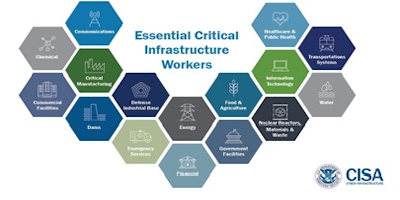Special Note:
America’s Pig Farmers Are Part of the Nation’s Essential Critical Infrastructure. As assigned by the
U.S. Department of Homeland
Security, the nation’s food and agriculture sector is one of 16 critical areas for our nation during this national emergency related to COVID-19. As such, the President has asked America’s farmers and those in all parts of the food chain to continue to work as normally as possible to help ensure that our domestic food supply remains uninterrupted.

Further, the President’s Coronavirus Guidelines State:
“If you work in a critical infrastructure industry, as defined by the Department of Homeland Security, such as healthcare services and pharmaceutical and food supply, you have a special responsibility to maintain your normal work schedule.”
Responsible Decision-making Is Everyone’s Responsibility
With all of this information in mind from the federal level, it’s important to always do what’s in the best interest for the health of yourself, your family, your employees, your community and your animals. Given this, please use the following FAQs to assist during this time.
Q: Is there a policy/protocol for on-farm entry during the COVID-19 outbreak?
• General visitors: At times of heightened biosecurity needs such as now, no general visitors should enter a production facility for the well-being of all farm workers, their families and the community. If the visit intent is for educational reasons, you can direct them to a virtual pig barn experience, such as this one from the North Carolina Pork Council.
• Employees: Any employee should stay home if sick for any reason. If an employee has been in a high-risk area known for COVID-19 or has been in contact with someone who has, they should self-quarantine for at least 14 days per recommendations by the U.S. Centers for Disease Control and Prevention (CDC).
Q: What is the best practice to know when to let an employee back on the farm following a known COVID-19 disease diagnosis and isolation?
• As of March 23, 2020, the CDC’s guidance following a known disease occurrence of COVID-19, is employees are okay to lift their isolation and return to work if the following conditions are met: o It has been at least seven days since the onset of their disease.
o They have been fever-free for at least three days without the use of fever-reducing medication.
o They are currently free of any symptoms of disease. o Alternatively, with improving signs, the resolution of fever and two negative tests 24 hours apart, the isolation also can be lifted. This approach is considered the test-based strategy approach and is dependent upon the availability of test kits. o For more information on the terms for lifting the isolation requirement for COVID-19, see CDC’s guidance for discontinuation of home isolation.
Q: What are the best practices for hiring/onboarding/interviewing potential employees?
• For now, virtual interviews are a best practice. However, when an in-person meeting is needed or when the new hire first starts to work, know what questions are legal to ask and which are not. According to Faegre Drinker Biddle & Reath LLP, which also has this COVID-19 Resource Page, good rules to remember include: o The Americans with Disability Act (ADA) prohibits employers from conducting medical examinations of applicants before a conditional offer of employment is made (including taking temperature).
o If a conditional offer of employment has been made, the ADA permits employers to conduct a pre-employment medical examination (which could include taking temperature), provided all employees in the same job category are treated the same.
o Without requesting specific medical information, however, you can request anyone exhibiting symptoms, feeling sick or recently exposed to someone testing positive/ presumed positive or is in a high-risk scenario (such as recent international travel) remain at home and not visit the facility.
o As an employer, communicate the necessary health requirements to work on the farm, including posting signs at facility entrances with instructions for individuals with a fever or symptoms on how to notify those in charge before they enter a farm facility. Post on your farm’s website as well if possible.
Q: What are the best practices before allowing new or existing employees to come onto a farm? Is it legal/feasible to require temperature checks for employees?
• Typically, implementing employee temperature checks is not advisable. However, the Equal Employment Opportunity Commission (EEOC) revised guidance on March 18, 2020, and due to community spread of COVID-19, employers may measure employees’ body temperature. See the EEOC COVID-19 Resource Page for more information.
• Because taking a temperature may be considered a medical examination, it is recommended producers use medical personnel to do so, for both risk avoidance and perception reasons. Alternatively, use someone in human resources or another management position.
• Because this is a medical examination, the results need to be kept confidential, which makes a checkpoint difficult. A workaround could be having a drive-thru checkpoint, which also would avoid individuals congregating in one space. As such, it’s recommended that no records be created for normal temperatures so you don’t have to worry about maintaining confidentiality of medical records.
• The CDC is advising that 100.4 degrees is a cutoff point for sending employees home, but some employers are rounding down to 100 degrees. Note that not all individuals testing positive have
a fever. Individuals who feel sick but not feverish should stay home, as well as those who have been recently exposed, as discussed above.
Click here to see more...